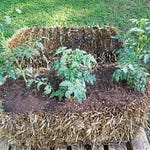This article is the second in my "getting started" series, where the intent is to provide a crash course in how to design a very simple gardening space that employs some basic permaculture principles. Previously, I wrote about finding the right spot; today the discussion will be all about the relationship between mulches and soil health.
Even hard clay soil can be dramatically improved when the soil organisms in it are given what they need to thrive.
Great gardens have great soil but, sadly, not every site has this feature, especially here in our little rocky corner of the country. On the bright side, even the most pathetic soils (such as the hard-pan clay and rock that I started with in my backyard) can be dramatically improved by using permaculture techniques.
The Permaculture Approach to Soil Health
In a natural system, such as a field, we see the surface covered in decaying plant matter, the top soil, and then the subsoil.
Permaculture gardens are productive because they have healthy soil, and they achieve this by treating the soil like a complex living organism — rather than a dead sponge to which chemicals are to be added. Take a quick walk through any forest, and you will observe an extraordinary diversity of plant life, all thriving without irrigation systems, chemical fertilizers, pesticides, or gardeners. In a permaculture garden, we adopt this model, and design a gardening space that works with nature, rather than against it. We design a garden that takes care of itself.
In our gardens, we want soil that will support the plants that we intend to eat. Unfortunately, many of these plants require excellent soil to grow well. Given our understanding of how worms and other organisms can improve our soil, we design our garden with this in mind, and create an environment that is favourable to worms and other beneficial organisms. This means providing these organisms with plenty of organic matter for them to eat, and keeping the soil constantly moist and loose so they can get around and feel comfortable. Given enough time, these organisms will improve soil health, so keeping them happy is paramount, and a permaculture approach makes this surprisingly easy to do.
Digging in
If your soil is good, then all it may need is a little cultivation (weeding and loosening it up), and you can plant right in it. If there is a broad variety of weeds and grasses, a few worms in every shovelful and it is nice and loamy (loose), then it is likely (but not guaranteed) that the soil has a good balance of nutrients, has a pH close to neutral, and has the right composition to offer proper drainage, proper water retention and reasonable ease for roots to grow. If any or all of these elements are missing, then the soil conditions are less than ideal and it will need to be amended.
Poor soils might have too much sand or clay, or be too acidic or alkaline, or they may lack the recommended amount of any of the essential nutrients (nitrogen, phosphorous and potassium, aka NPK). Of course, the easiest way to determine this is to get a soil test done by your local agricultural extension office, but that having been said, I've never done it. For whatever reason, I have always been keen to just tinker around and experiment. Luckily for me, this inclination works well with a permaculture approach to gardening.
If your soil is poor in some way, the first step toward bringing it back to health is to add organic matter to the soil and the best bang for your buck here is manure. Different manures have different properties, but if you are doing this work in the spring then whatever you use should be well aged (have sat/composted for at least a year). I have always used horse manure, because it is usually free. While it tends to have a lot of weed seeds in it, they only germinate once, and are not a big deal in the broader scheme of things (I plan to do an article on manure later, so stay tuned). Suffice it to say, for every manure except horse manure, do not add too much: an inch or two spread over your gardening area will be enough to charge it up for a season, but too much may actually hurt your plants.
Building up
Of course, if the thought of breaking up the ground with a pickaxe and working in manure with a shovel and pitchfork does not appeal to you, there is always the option of constructing some sort of box (a.k.a. raised bed), and simply pouring good soil on top of the existing soil. I advise strongly against going too high here, and despite the raging raised-bed craze that has taken North America by storm in recent years, I have found that little is to be gained by going any higher than 6 inches (follow-up article on this topic to come).
Also, I would not place a great deal of faith in any "organic gardening soil" that you might purchase at a garden center because I find many of them to have a very high proportion of sand, so if you are building up above grade, all that sand will cause the water to go down to where your plants can't reach it. Of course, if garden center soil is all that you have access to, add organic matter (rotten leaves, seaweed, manure, grass clippings) to the soil to help it retain water.
In a permaculture garden, we copy how natural systems use mulch to feed the soil, maintain moisture levels and protect the organisms that maintain the soil.
Cover it
Last but certainly not least, like any soil anywhere in nature, yours needs a cover, and that means mulch. Any organic material will do, but the ideal choice is whatever is free and nearby. Hay, straw, leaves, grass clippings, and ramial wood chips (the chips from small and medium-size branches that are made by tree services), needles, seaweed, or even smashed up rotten logs will do the job here. This mulch will feed the organisms in the soil, leach nutrients and minerals into the soil every time it rains and keep the moisture levels constant. In essence, the mulch creates an environment that is favourable to organisms that improve and maintain soil health — and this will mean less work and better yields over the long run. Personally - I use whatever I can get for free and with minimal work.
The forest floor receives a natural application of mulch each year as leaves, needles, and branches fall annually with the seasons.
Final Thoughts
So those are the basics for getting the soil ready. Of course, there is much more that I could have written on many of the subtopics that have been discussed so far and I'll do that in future articles. For now, my goal is to get you thinking about a spot, and to start sourcing out the soil, amendments, and mulches you will need. In my next article, I'll discuss the basic equipment you should have for gardening and you might be surprised at how inexpensive it can be to get started.















